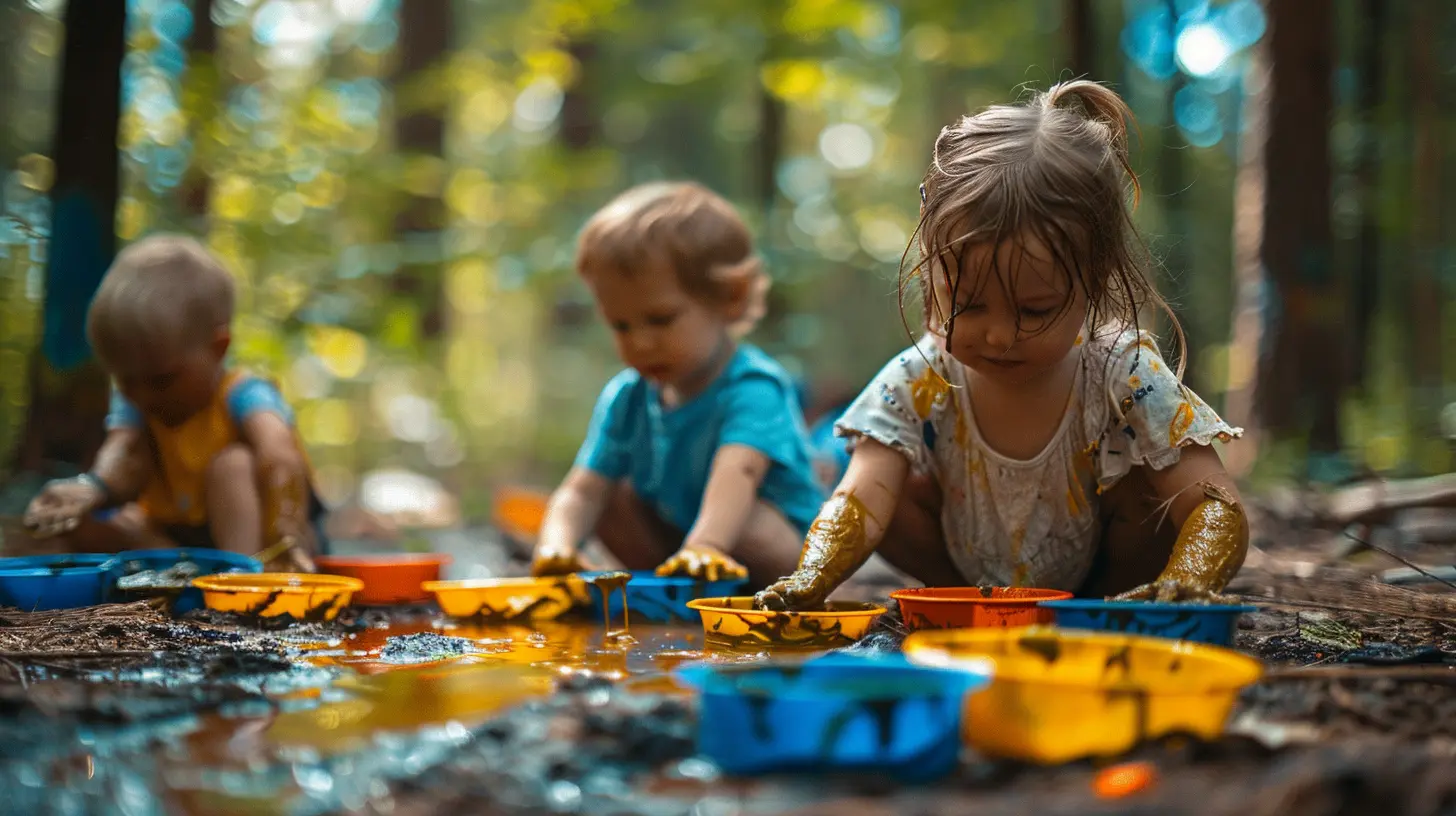Encouraging Creativity in Your Children Through Play
25 November 2024
Creativity is one of the most crucial skills that children can develop in their early years. It allows them to think outside the box, solve problems, and express themselves in a world that is constantly evolving. But how can we, as parents, foster our child's creativity while still letting them be kids? The answer might surprise you: through play.
Playtime is not just about keeping children entertained. It's a powerful opportunity to stimulate their imagination, boost critical thinking, and encourage creative exploration. In this article, we'll dive into tips and strategies that you can use to encourage creativity in your children through play.
Why Is Creativity Important in Children?
Before we get into the ‘how,’ let’s understand the ‘why.’ Why is creativity even important for kids? Well, here’s the thing: creativity isn’t just about being good at drawing, painting, or singing. It’s a way of thinking!1. Problem Solving
Creativity and problem-solving go hand in hand. When children engage in creative play, they encounter problems that require fresh, innovative solutions. Whether it’s building a tower with blocks or making up a game, they use creative thinking to figure things out. This skill will help them in school, work, and life.2. Emotional Expression
Children often have a hard time expressing their feelings with words. Creative activities like drawing, pretend play, or storytelling provide them with a non-verbal outlet for their emotions. It’s their way of saying, “Hey, this is how I feel,” without having to articulate it.3. Cognitive Flexibility
Creative play fosters cognitive flexibility, which is the brain's ability to switch between thinking about two different concepts or to think about multiple concepts simultaneously. This skill is crucial for adaptability and innovation.
The Power of Play in Encouraging Creativity
Now that we understand why creativity is so important, how do we encourage it? Let’s talk play.Play isn’t merely about toys and games. In a child’s world, play is their "work." It’s how they learn, grow, and most importantly, experiment with creativity. Whether it’s unstructured play where kids take charge or guided play with a parent or teacher, both can significantly boost a child’s creativity.
1. Unstructured Play: Letting Them Lead
Unstructured play, also known as free play, is when your child takes the reins and decides what to do. They may invent a game, go on an imaginary adventure, or build a fortress out of pillows. Unstructured play is gold for creativity because it gives them the freedom to explore without limitations.Some Ideas for Unstructured Play:
- Costume Play: Let them raid the closet for old clothes, hats, and scarves. They can pretend to be pirates, doctors, or anyone they want to be.- Outdoor Adventures: Like exploring the backyard or a nearby park. With a stick, they could be a knight defending a castle or an explorer discovering new lands.
- Building Games: Offer a set of building blocks or even everyday household items. Let them construct whatever comes to mind — a rocket ship, a house, or even something totally abstract. There's no wrong answer!
> Letting your child take the lead in play fosters independence and encourages creative thinking. The more in control they feel, the more their imagination can soar.
2. Structured Play: A Guided Experience
While unstructured play is invaluable, structured play also has its benefits. You, as a parent, can gently guide your child’s playtime with certain activities that encourage creativity while still allowing them plenty of freedom to innovate.Some Ideas for Structured Play:
- Art Projects: Set up crafts with paints, markers, and other art supplies. However, don’t give them too many instructions. Instead of saying, “draw a house,” ask, “What do you think you can create?” This opens up the possibilities.- Storytelling Together: Start a story with, “Once upon a time, there was a…” and let your child finish the sentence. Continue to build the story together. This engages their creative thinking and helps develop language skills along the way.
- Themed Days: Create a themed day—pirate day, space day, or even superhero day. Use costumes, props, and background settings to take their imagination on a journey. Encourage them to come up with stories or new characters for these themes.
While structured play can guide children towards specific creative outlets, make sure the activities aren't overly rigid. Stay flexible and leave room for improvisation.
How to Create a Creative Play Environment
No matter the type of play, setting up a creative-friendly environment is crucial. A space designed purely for play encourages children to explore and experiment with their ideas without distraction or the fear of making a mess.1. Provide Open-Ended Toys
Opt for open-ended toys like building blocks, LEGOs, or art supplies, which encourage creativity. Unlike electronic gadgets or toys that come with specific instructions, open-ended toys allow your child to use their imagination. For example, a set of wooden blocks can become a castle, a car, or even a spaceship.2. Limit Screen Time
Let’s face it. Technology seems to be everywhere these days. While some tech tools do stimulate creativity — think educational games or drawing apps — too much screen time can hinder imaginative thinking. Encourage your child to spend more time engaging in hands-on activities like drawing, building, or role-playing.3. Provide Space for Artistic Expression
Create an area where your child can freely express themselves. It doesn’t have to be fancy — a simple corner with paper and coloring supplies will do wonders. The key is to give them the freedom to draw, paint, build, and create without worrying about making a mess. Messes can always be cleaned up, but the creative process is priceless.
Fostering Imaginative Play: Techniques for Parents
You don’t have to be an art teacher or a genius with a paintbrush to encourage your child’s creativity. Sometimes, the simplest approaches can spark the most imaginative results.1. Be a Co-Player
Jump into their world once in a while. Sit down and participate in their imaginative games. Be the customer to their shop or the monster chasing them through the forest. Your involvement, even if it’s brief, can inspire and encourage them to explore different roles, situations, and problem-solving tactics.2. Ask Open-Ended Questions
Rather than asking, “Did you have fun playing with your toys?” (which encourages a yes or no answer), go deeper. Ask things like:- “What was your favorite part of the game?”
- “What adventure were you on today?”
- “What would happen if we changed this part of the story?”
Open-ended questions require more thought and spark further creative exploration.
3. Encourage Without Directing
During playtime, try not to suggest too many ideas. Instead of telling them what to do, let them take the lead. Sure, you can offer some light guidance, but avoid saying things like, “You should build a tall tower.” Instead, go for statements such as, “What do you think you could build with these blocks?” The goal is to stimulate their minds without overshadowing their imagination.Balancing Creativity with Structured Learning
It’s easy to get caught up in the hustle of daily life, where homework, extracurriculars, and screen time all fight for attention. But balancing mental stimulation with creative play is essential.1. Make Time for Play Every Day
With life being so busy, it’s tempting to prioritize structured educational activities. But remember, creativity is just as important. Make playtime as essential as reading time or homework. Even just 30 minutes can go a long way!2. Encourage Real-World Exploration
Not all play needs to happen indoors. Take your child on real-world explorations. Go to the park, visit a museum, or explore a nature trail. New environments spark curiosity and invite opportunities for creative thinking.3. Praise the Process, Not the Result
When encouraging creativity, always emphasize the process over the final product. Whether your child’s tower falls over or their painting is just a smudge of colors, it’s the act of engaging in play that matters.Final Thoughts
Creativity isn’t something that just comes from a classroom or a workbook. It's developed and nurtured through everyday play. From building with blocks to creating stories in their mind, children use play as their personal canvas to explore the world and their place in it.By offering opportunities for both structured and unstructured play, creating a supportive environment, and jumping into their world every now and then, you’ll be giving your child the tools they need to grow as confident, imaginative thinkers.
Because in a world where things are constantly changing, creativity will always be your child’s best tool.
all images in this post were generated using AI tools
Category:
MotherhoodAuthor:

Zelda Gill
Discussion
rate this article
14 comments
Karina McConkey
This article highlights the importance of play in fostering creativity in children. It offers practical tips that are easy to implement at home. As a parent, I appreciate the emphasis on letting kids explore freely, as it truly nurtures their imagination and self-expression. Great insights!
February 2, 2025 at 4:54 AM

Zelda Gill
Thank you for your kind words! I'm glad you found the tips helpful. Encouraging creativity through play is so important for our children's development!
Nora McMeekin
This article offers fantastic insights on fostering creativity in children. Play is such a powerful tool for their imagination and problem-solving skills. Practical tips make it easy for parents to encourage this essential development.
January 29, 2025 at 5:16 AM

Zelda Gill
Thank you for your kind words! I'm glad you found the insights and tips valuable for fostering creativity in children through play.
Dusk O'Neal
Unleash the magic of imagination! By embracing play, we nurture creativity in our children, empowering them to explore, innovate, and express themselves. Let their dreams soar!
January 25, 2025 at 4:07 PM

Zelda Gill
Absolutely! Play is essential for fostering creativity and self-expression in children. Let's encourage their imaginations to thrive!
Sydney Matthews
Play sparks imagination—let's nurture their creativity!
January 21, 2025 at 6:03 PM

Zelda Gill
Absolutely! Play is a vital tool for fostering creativity and imagination in children. Let's encourage and support their playful explorations!
Icarus McVaney
Play fosters imagination and valuable problem-solving skills!
January 17, 2025 at 5:07 AM

Zelda Gill
Absolutely! Play is a vital pathway for children to develop creativity, imagination, and essential problem-solving skills.
Azurael Kirk
Loved this article! Encouraging creativity through play is essential for child development. Simple, open-ended activities foster imagination and problem-solving skills. Letting kids take the lead allows them to explore their interests, building confidence and lifelong creative habits. Great tips!
January 12, 2025 at 4:35 PM

Zelda Gill
Thank you for your insightful comment! I'm glad you found the tips helpful in promoting creativity through play. Your points about fostering imagination and confidence are spot on!
Orionyx Acevedo
Empower your child's imagination—play sparks creativity and builds lifelong confidence. Let them explore!
January 7, 2025 at 5:16 PM

Zelda Gill
Absolutely! Play is essential for fostering creativity and confidence in children. It allows them to explore their imagination freely.
Drew Pace
What a fascinating approach to fostering creativity! I love the idea of using play as a tool for self-expression. I’m curious about specific activities that can ignite imagination. Can’t wait to try some of these ideas!
January 4, 2025 at 3:55 PM

Zelda Gill
Thank you for your enthusiasm! Some activities to spark imagination include storytelling games, art sessions with open-ended materials, and interactive role-playing. Enjoy exploring these creative play ideas with your children!
Tracie Lawrence
What a wonderful reminder! Play is such a magical way to spark creativity in our kids. Let’s embrace those playful moments and watch their imaginations soar! 🌟🎨
December 30, 2024 at 4:21 AM

Zelda Gill
Thank you! Embracing play truly unlocks endless creativity in children. Let’s inspire that magic together! 🌈✨
Sheena McDonald
Creativity flourishes in the freedom of play, where imagination knows no bounds. By nurturing this space, we equip our children not just to dream, but to transform their dreams into reality.
December 22, 2024 at 4:50 PM

Zelda Gill
Absolutely! Play is essential for fostering creativity in children, allowing them to explore, imagine, and turn their dreams into tangible outcomes.
Mistral Phelps
Who knew a cardboard box could spark a rocket to Mars? Encourage your little Picasso to splatter paint on the walls (just a section, promise!) and watch their imaginations take flight! Playtime isn’t just fun; it’s a passport to creativity. Bring on the glitter and giggles!
December 15, 2024 at 5:15 AM

Zelda Gill
Absolutely! Play ignites creativity in kids, turning everyday items like cardboard boxes into imaginative adventures. Let them explore and express themselves—it's all part of the creative journey!
Grey Forbes
Love this! Play is such a powerful tool for nurturing creativity. Keep inspiring your kids to explore and imagine!
December 5, 2024 at 5:26 AM

Zelda Gill
Thank you! I completely agree—play fuels creativity and imagination. Let's keep inspiring our kids to explore!
Paul Cummings
Play is the gateway to creativity! Encourage your children to explore, imagine, and express themselves freely. These moments of joy will nurture their innovative spirit and lifelong love for learning!
November 29, 2024 at 5:34 AM

Zelda Gill
Absolutely! Play is essential for fostering creativity and innovation in children. Let's continue to support their exploration and self-expression!
Eleanor Flores
Play is essential for fostering creativity—let kids explore, imagine, and express themselves freely!
November 28, 2024 at 4:05 AM

Zelda Gill
Absolutely! Play is a vital driver of creativity, allowing children to explore and express their unique ideas. Encouraging this freedom helps nurture their imaginative skills and confidence.
MORE POSTS

Essential Tips for Soothing Your Newborn at Night

How to Support Your Child Through Bullying at School

Sibling Bullying: How to Keep the Peace at Home

Toddler Milestones: What to Expect and How to Support Growth

Why Emotional Intelligence is Key to Problem-Solving

Redefining Productivity as Part of Self-Care

How to Create an Outdoor Adventure Box for Kids

How to Set Up a Backyard Camping Experience

Think Parenting is a Joke? Sometimes, It Should Be!